Introduction
Knowledge of the Stone Age grows by slow steps. Tools and techniques of ancient men are unfamiliar to us, and we understand them with difficulty. Field work and laboratory studies supplement each other. The modern approach to the history of technology is multi-pronged. In the laboratory, it requires refined microscopy, elaborate preparation of specimens, and study of large samples. In the field, it must provide contexts, dates, and geographic distributions for ancient tool types. Studies alternate between the laboratory and the field, as each raises problems that must be answered in the other realm. With each gain in knowledge, problems become more difficult and techniques more demanding.
Studies of Tool Use
Any archaeological collection has a plethora of well-recognized tools, called arrowheads, scrapers, celts, or what have you. Everyone has fixed opinions about their use, opinions which are generally untested and are often false. With each type, one basic problem is, “What was it used for?” This problem is still unanswered for most of the implements used by ancient man. Many of our opinions concerning the functions of stone tools are vulgar errors.
Methods for discovering use are coming into existence. Some involve techniques of the nineteenth century, standard in other sciences. Others require analytic thinking about evidence and reappraisal of old concepts with an open mind. In determining the use of an ancient tool, we must have access to large samples, and samples must not be distorted by prejudices of the collector. Damaged specimens and fragments are especially important. Several types of evidence are used together.
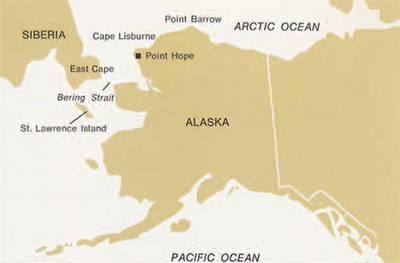
Wear-traces and use-marks, which occur on only a small percentage of any series, require sophisticate microscopy. The student who is nearsighted has an advantage in the preliminary sorting of samples, in selecting of specimens for cleaning, staining, and study under lenses. Lighting a specimen is the most critical art. Low-powered objectives of the microscope and strong hand-lenses are most useful tools, but even the electron microscope may sometimes be a help.
Next to the study of wear-marks, breakage patterns are the most important evidence. Knife blades were snapped off in a different manner than were spearpoints. Arrow tips shattered in different ways than did spearpoints. Damage to the chisel end was different from the break-down of a scraper edge.
The manner of reshaping a damaged tool-edge is next in importance. When a spearpoint was broken while hunting, its tip was sometimes repointed. As a knife blade wore, its edges were resharpened. In any large sample, one can lay out stages of repointing or of resharpening. Other tool types can also be sorted into stages of reshaping and of progression toward a worn-out stump.
Ethnographic parallels are always of significance, although they are unfortunately rare. Modern technologies of the Australian, the Papuan, and the Eskimo are full of surprises, and offer insight into ancient industries. The precious relics of ancient frontiers (hafted tools of known date and place in our ethnographic collections) are filled with information for the student who will look at them with curiosity. However, many archaeological tool types have no parallel in surviving primitive cultures, and represent devices we would never have imagined.
Archaeological tools which have been preserved in their handles and haftings are as meaningful as ethnographic specimens. The ordinary Basket-maker and Desert Culture “arrowheads” of our Southwest, when they have been found in hafts are actually in knife handles. Wear-traces on loose specimens also indicate that they were knife blades. It seems probably that many peoples used no flint spearpoints, that the darts for their spearthrowers were armed with hardwood or bone tips.
Finally, parallels between the functional details of flint tools and those of modern crafts must always be kept in mind. The blade of the milling machine, the cutter-head of the lathe, details of the carpenter’s plane, chisel, and saw, are all important. They represent relationships between the tool (hardness, elasticity, angle and form of edge) and the material of the object worked (hardness, cohesion, elasticity). In the design of cutting edges, a modern mechanic follows the same principles as did a Stone Age mechanic. Modern studies of elasticity, strength, and hardness of flints are meaningful. The basic principles of mechanics are relevant to stone tools, just as they are to the operation of a turret-lathe. An apprenticeship to Steel Age mechanics may be indispensable to the archaeologist.
This long preamble on principles of technological analysis is offered because such analysis is a major effort of modern archaeology. Its progress is slow: eye-strain and collection of non-skewed samples are arduous. A student leaves the laboratory with many a headache and many a doubt, seeking other techniques, knowing that he has worked for many days without finding a significant specimen. He remembers the chips and debris discarded in the field, samples which well might answer the present problem if only it had been forseen. He has many doubts about what is seen, and deals with many uncertainties.
Yet with every tool from the past, a type can be defined, dated, and mapped. Its function can be described if one has large enough samples and can apply the right thinking. This approach is a great promise, a great effort, and is a slow understanding in archaeology today. It is a leap beyond typology, classification, and descriptive archaeology. It is a new way of thinking about the work of the mind and hand. It is one fruitful new insight into world archaeology.
This is the manner in which we have been dealing with the so-called arrowheads and scrapers of the United States, finding a greater variety in function with every step. Back of this we can begin to glimpse the relationships of man to tools, the rich variety of techniques with which men have solved problems of life in past ages. An expert mechanic is implied in every industry which we have examined.
A Technological Analysis of Eskimo Arrowpoints
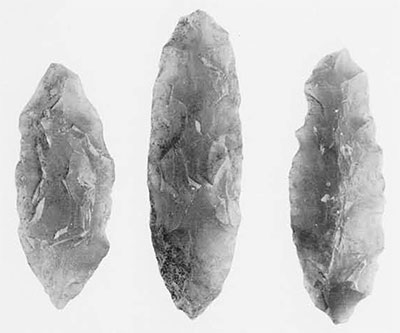
Eskimo tools are critical, and yet treacherous, to many problems in primitive technology. Collections must be used with caution and criticism, since they include fraudulent specimens and native reconstructions. One is often hard put to tell the difference between a genuine clue to Stone Age technology and an idea newly invented by a native informant. Collections include genuine craft examples from the modern Eskimo, heirloom specimens purchased in an Eskimo community, good archaeological specimens dug from older sites, and reconstructed, mated, or reshaped archaeological objects which the modern Eskimo have improved for a commercial relic market.
The Alaskan Eskimo are remarkable for commercial pot-hunting in the sites of their ancestors (this started before 1850), for faking hafted specimens from archaeological fragments, and for genuine knowledge of ancient crafts. Old collections are filled with tourist pieces. Yet, at the same time, Alaskan Eskimo collections include honest ethnographic specimens, choice archaeological objects, and good archaeological survey collections. I believe they can be sorted and used to good advantage. One must outwit Eskimo skills to distinguish true from false.
In a discussion of local spearpoint types, I suggested to Frances Eyman and Douglas Anderson that the flint arrowpoints of the Point Barrow Eskimo had been misidentified. I refused to accept the quiver-lots that I had seen, in which weathered points had been lashed into crudely split arrowshafts of perfectly fresh wood. I thought that their size indicated that these stone tools might be lance tips or knife blades. They had not been studied and their status was in doubt until a large group could be examined.
When I returned to Philadelphia, I found that Miss Eyman had assembled Alaskan arrowpoints and related tools for my examination. The most important of these was a series of more than a thousand recent flint arrowpoints, whole and broken, from northern Alaska. They had been purchased from natives in wholesale quantities prior to 1920. At that time, the Eskimo were digging out recent house sites and middens that were obvious as elevations on the ground surface, and they rarely got into older sites that did not show above ground. Harpoon parts and other tools in the same collections are almost all from the last few centuries of Eskimo history. The arrowpoints thus represent a large controlled series well suited to technological analysis.
As I worked with the series and began to sort it into groups of sub-types, it became apparent that none of the tools showed wear on their edges or signs that their edges had been resharpened. Although many of them were serrate, a common feature of knife blades, there was no evidence of knife use. On the other hand, a significant number showed truncation, a common method of repointing projectile points when a broken tip was repaired in the field. Some also showed a peculiar type of damage by tip-impact, in which a long longitudinal flake resembling a flute or a burin scar had been struck off when the tip was driven against bone. This is an unusual detail which needs further discussion. A large number of arrowpoints had been reused as other tools. Most striking are those used as whetstones. Many more had been reused as drill tips, with either end (or both) showing wear-marks from rotation. Most drills had been rechipped from whole or broken arrowpoints, but many of them had been used without modification. I don’t know whether they were reused at the time when the arrowpoints were in use, or whether they represent the much later use of archaeological specimens, but I suspect that most of the drill tips were reused in modern times. The table shows the number of specimens of each variety.
The manufacture of Eskimo arrow tips was observed at Cape Lisburne in 1825 by Edward belcher, Surveyor to a British exploring expedition led by Frederick William Beechey. Large flakes were detached from a block of flint by light blows from a mallet-like hammer. The head of the flaking hammer was a heavy block of jade with flat faces. The flake was lashed into a split wooden anvil and roughed out with hammer blows. It was then clamped, edge up, over a hollow on a log anvil, and completed by pressure-flaking. Flakes were pressed off from alternating faces of the blank, staring at one end of the edge and progressing to the other end.
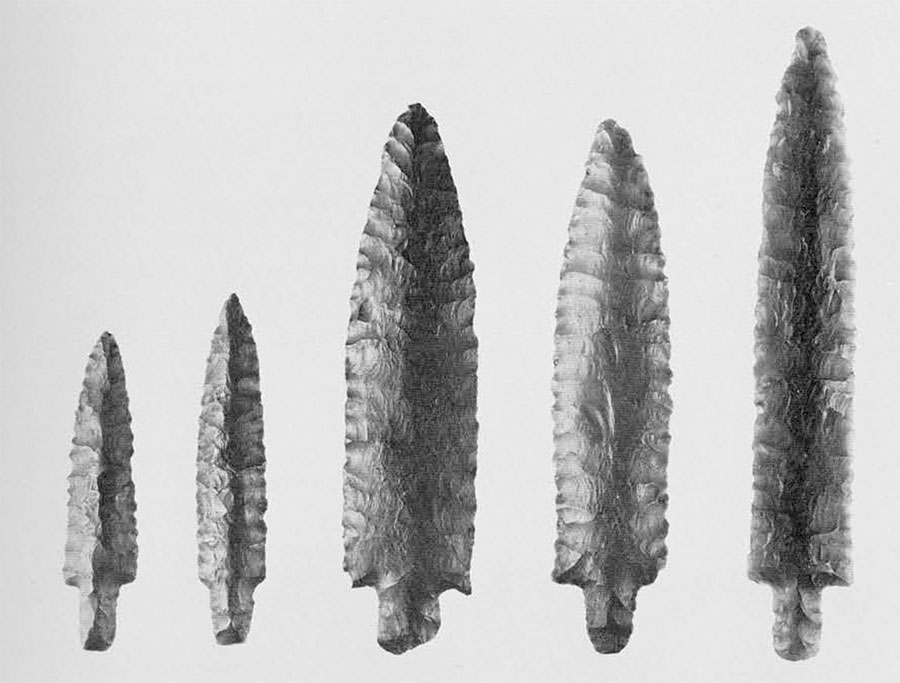
The points are long, narrow, and thick, with a diamond-shaped cross section. The pressure flakes run to the center of the blade, and their bulbar scars form serrations at its edge. The length, evenness, and parallel margins of the flake scars indicate that a large force was applied through the pressure-flaking tool. The technology is of interest because it is one of the relatively few well-documented examples of the pressure-flaking of flint, a technique frequently postulated but seldom demonstrated. It differs markedly from the pressure-flaking of North American Indians in historic times, where flakes were short, non-parallel, sheet-like, and were drawn by much less force by short bars of antler held in one hand.
The flaking tools are well known. A few good ethnological specimens, collected by Belcher and other explorers, have been preserved. More specimens have been dug from frozen sites by the modern Eskimo and sold to collectors. The tool is rarely found intact, with the working tip still in the handle. The University Museum collections include a good series of handles to flaking tools in ivory and wood, and a good sample of loose tips which were made from pieces of walrus rib. These are all archaeological specimens. Almost half of the handles have been fitted with tips which were not original to them. Some tips are bars of steel or copper, some archaeological fragments. In all cases the tourist pieces have tips that are poorly fitted to handles, obviously not made for use, and hafts have been crudely cut and reshaped. The genuine archaeological tips are all of walrus bone, while the reconstructions abound in metal ends, which were probably never used.
However, these collections do include one specimen which meets all the criteria of a genuine Eskimo tool. Like the incomplete specimens, it is a two-handed implement, the base of the handle shaped to fit the palm of the right hand, allowing space for the left hand near the working end. The tip is set into a slot cut into the top of the handle, and, as with all genuine Eskimo hafting, it fits into the handle as though it had grown there. The handle is somewhat longer than most examples, was carved from a piece of fossil mammoth ivory, and is highly finished and polished.
Thus the flaking style of the Bering Strait Eskimo arrowpoints is associated with a long two-handled flaking tool so formed that the greatest amount of force could be applied in pressing off flakes. I believe that long regular flakes can be pressure-drawn only by the use of great force, and that a two-handed tool was essential to the Eskimo flint technology. In American Indian lithic industries, certain late Paleo-Indian flint technologies of about 9,000 years ago show the closest resemblances to the Eskimo arrow tip. Especially the Eden Valley, Wyoming spearpoint types, with parallel, narrow flake scars and diamond-shaped cross section, are so much like them that one would suspect the same flaking technique. the two projectile point types cannot have any historical relationship, and their similarities were the result of convergence or parallelism in technological evolution.
Breakage Patterns on the Eskimo Arrow Tips

The long flute-like and burin-like flake scars produced by damage are peculiar, and are hard to match in any other series of flint projectile points. In very large collections of Late Archaic and Early Woodland projectile points from Pennsylvania, representing stone tips of javelins which were propelled by the spearthrower, this type of impact damage occurs on less than one specimen in ten thousand. Late arrowpoints of the United States, which were driven by a powerful bow, show entirely different breakage patterns, with shattering and length wise splitting of the arrowpoint usual. The Eskimo breakage pattern indicates that the mechanics of the Eskimo bow and arrow were quite different from those of the Indian bow, and had more in common with those of the spearthrower. A tentative analysis of the mechanics of Eskimo and Indian archery helps to explain the peculiar damage patterns of the Eskimo arrow tips.
Modern archery tackle from Alaska throws little light on the problem, for the bows and arrows are decadent. Old specimens and archaeological fragments from the central and western Arctic indicate that the Alaskan bow and arrow had gone furthest in one direction of specialization, an evolution opposite to that of the archery of Indians within the present United States. Contrasting breakage patterns on different series of arrowpoints are the results of the divergent evolution of distinct systems of archery. The Eskimo arrow tips of Alaska include some of the largest and heaviest points used anywhere in the world; recent points from the United States, some of the smallest and lightest. Both are but fragments of contrasting mechanical systems.
The Indian arrow was a weapon of high velocity and small mass. Its stone tip was usually tiny, and was generally set into a foreshaft of hard, heavy wood. The rearshaft was usually of arrowreed or light wood, concentrating the greatest mass near the front of the arrow, yet keeping total weight to the absolute minimum. Three feathered vanes, cut very low, acted with the forward center of balance to keep the arrow straight in flight. The bow was made as short as possible, and drawn into as tight an arc as possible, so that the velocity of the arrow came to its peak in the shortest possible time. Feathering, tip size, shaft diameter, and bowstring diameter were minimized so as to reduce loss of force to air friction. The Indian arrow was a projectile in which mass was kept to the minimum and velocity stepped up to its maximum, thus being analogous to a high speed .22 caliber rifle bullet in contrast to a shotgun slug.
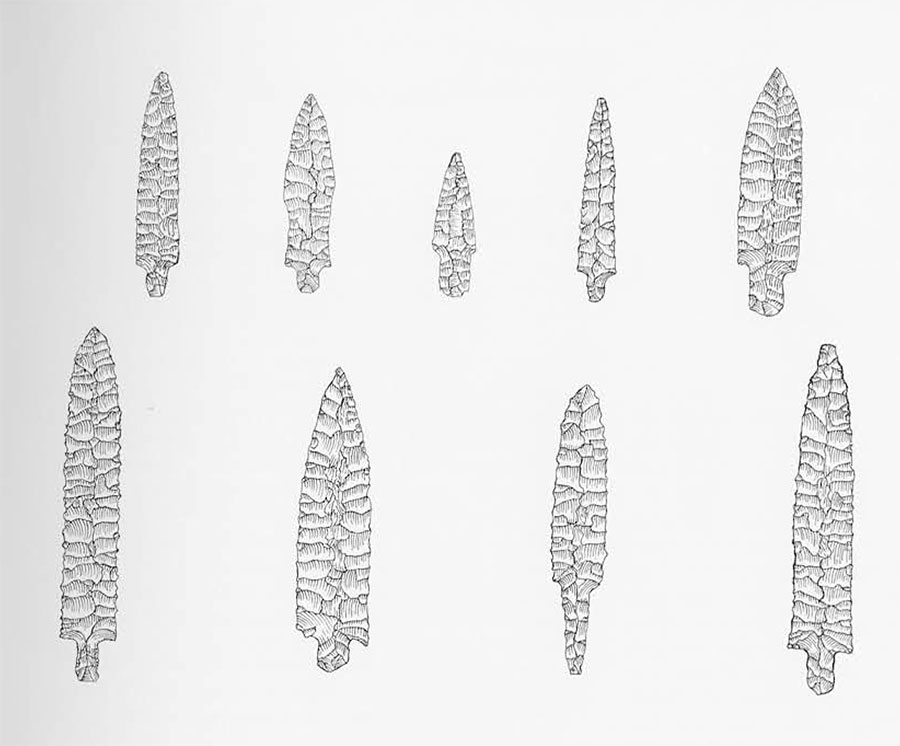
The Eskimo system of archery was more like the shotgun, and that of the Bering Strait area had gone furthest in that direction. The stone tip was large, and was set into a heavy, barbed foreshaft of bone. The rearshaft was of large diameter, fletched with two feathers or unfletched. The arrow was a high mass, low velocity projectile. Driven from the same bow, Indian and Eskimo arrows would deliver almost the same amount of energy upon impact (except for different losses in speed due to air friction). One depended more upon velocity, the other upon weight, this being a reciprocal relationship. The Indian arrow would have a flatter trajectory and a longer range. The Eskimo arrow was more of a short-range missile. It produced more shock upon impact, wheras the Indian arrow penetrated more deeply and cut more flesh.
The Eskimo bow was the most complex, but not the best, in the New World. Its staff was made from several pieces of driftwood (or, in some cases, bone, horn, antler, or ivory) which were jointed, glued, and bound together to make a reflexed form. Most of the force of the bow was supplied by its sinew bracing, an elaborate net of taut cords which were interlaced up and down the back of the bow. Tension on individual strands was adjusted by twisting them with little wrenches. This mechanism might be compared to a motor made up of rubber bands. The bows were heavy; we judge that they pulled more than seventy pounds, although none are well-enough preserved to permit tests. Their cast is slow, well adapted to a heavy arrow which requires much force to accelerate its mass, but incapable of bringing a light flight-arrow to maximum velocity.
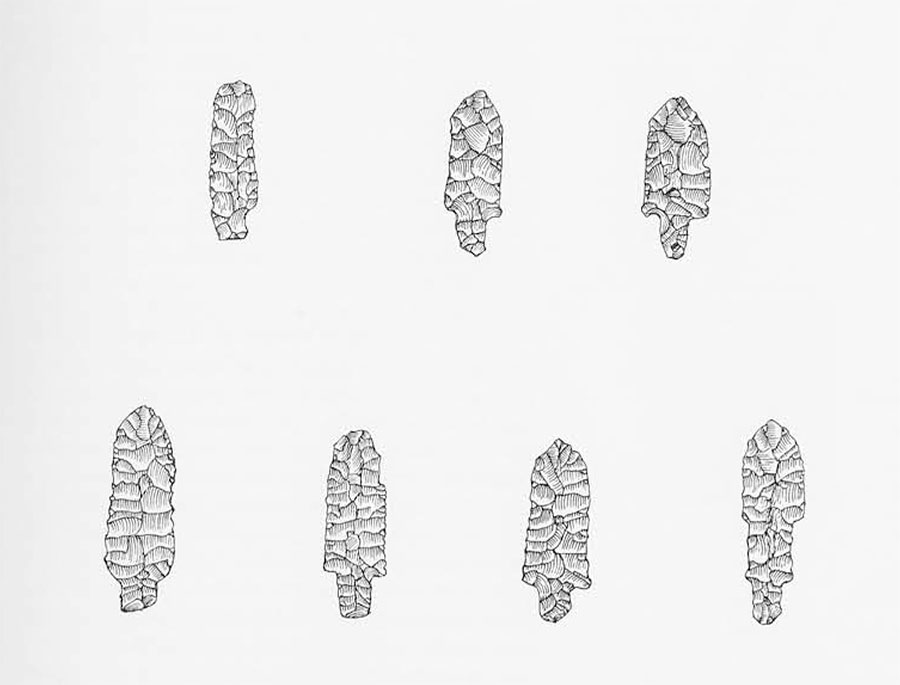
The Eskimo flint arrowpoint was thus part of a specialized mechanical system, involving a slow and heavy arrow cast from a slow but powerful bow. This arrow was used almost exclusively for caribou hunting, but was sometimes turned against bears and humans. Thus Eskimo archery stressed a short-range arrow of great force and terrible shock power. The kinetic energy of a projectile is a factor of mass times velocity. Both can be varied, and the same energy delivered upon impact by a heavy slow arrow as by a light swift one. Eskimo archery so stressed mass of projectile that the slow speed at impact approximated the speed of the blow required to draw a burin flake or draw a flute from a flint tool. Breakage patterns of projectile points are factors of the mechanics of the whole delivery of the weapon system.
Reused Arrowpoints

Absence of edge wear and complete negative evidence of any knife use on Eskimo arrowpoints is surprising, for their long, sharp, serrate edges seem well adapted to cutting and butchering. If any were pressed into use as knives, the archaeology and the ethnography fail to suggest it. The large number of drill points made from arrow tips is also curious, for earlier Eskimo horizons and the Eskimo sites of other areas do not have drill tips in large numbers, and many of these were of steel, judging by the holes drilled in bone and ivory objects. The flint drill tip seems to be correlated with the commercial carving of ivory by the Bering Strait Eskimo, and the abundance of flint drill tip with the recent expansion of this industry. Many of them may have been rechipped and used by the same men who collected arrowpoints to sell, and were added to the dealer’s stock when worn.
Arrowpoints reused as hone are more puzzling. Some are only slightly worn, with high spots and edges smoothed, others are at intermediate stages of use, and some have had all traces of flaking worn away. Flint makes an excellent fine-grained hone for putting very sharp edges on steel tools, and our collections include several spalls of flint which are worn as hones and which have steel dust and rust impacted in their surfaces. None of the used arrowpoints has any trace of metal or rust in or on its surfaces, so they must have been used against stone. They were well adapted to shaping the final edge on a jade or slate tool, and they are so well worn that they must have been in everyday use. Several have thongs attached to them and probably came from frozen archaeological sites. They seem to be contemporary with flint arrowpoints and to be part of a basic eighteenth century Eskimo industry.
